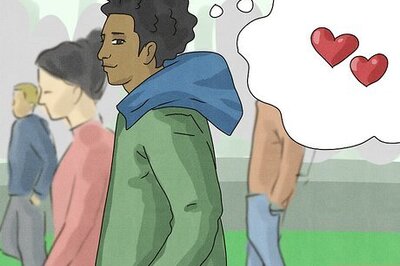
views
What is the Find Steed spell in D&D 5e?
Find Steed is a 2nd-level conjuration spell for paladins. Paladins are holy warriors who draw the power to smite enemies from a sacred oath—and Find Steed is a special spell that only paladins have the ability to cast. As the name suggests, Find Steed gives paladins the means to summon a faithful mount, truly making them the knights in shining armor they’re meant to be! Casting time: 10 minutes Range: 30 feet Target: An unoccupied space within range Components: Verbal and somatic Duration: Instantaneous Classes: Paladin
How does Find Steed work?
Find Steed creates an ongoing bond with an intelligent, loyal steed. When you cast Find Steed (which takes 10 in-game minutes to do), a steed of your choice will appear in an empty spot within range. It adopts statistics of its chosen form, but is still classified as a celestial, fey, or fiend (you choose which), has an Intelligence of 6, and has the ability to understand a language of your choice. You can choose from a: Warhorse Pony Camel Elk Mastiff Custom forms (the DM may allow you to summon a different animal as a steed if you ask)
You can ride your steed in combat and communicate with it. Steeds summoned with this spell can serve as mounts, allowing you to use mounted combat during battles (and ride your steed outside of battle, too). While mounted, all spells that target only you can also target your steed—and as long as your steed is within a mile of you, you can communicate telepathically. When you summon a steed with the Find Steed spell, your paladin and their steed will share an instinctive bond—one that lets them fight in total sync during combat. Just remember that you can’t bond to more than one steed at a time with this spell; to get a new one, you must release your current steed as an action (which you can do anytime).
Steeds disappear when they drop to 0 hit points. It’s possible for a magically summoned steed to get hurt, just like any other creature in D&D. Your steed will have a certain number of hit points (HP) depending on its form—and if the steed is reduced to 0 HP, it’ll simply disappear. Casting Find Steed again will summon the steed back with all its HP restored. If you’re exploring an area or going into a fight where you can’t bring your steed, you can also choose to dismiss your steed as an action. When you dismiss your steed temporarily, casting Find Steed will once again summon it back (with all HP restored).
How to Use Find Steed
Cover more ground in battles with your steed. All creatures have a set movement speed that dictates how fast they can move in a single round—and, typically, steeds (like horses or elk) can move faster than the average D&D character. So, if your paladin is mounted on a steed, that means they’ll have more movement in combat, which can be super helpful in controlling the battlefield. For example, the average movement speed of most D&D characters (without feats or extra abilities) is 30 feet per round, whereas warhorses have a 60-foot movement speed. So, if your paladin is mounted on their warhorse steed, that means they can move 60 feet per round instead of 30—or 120 feet if the warhorse Dashes (uses an action to move again).
Scout ahead of the party with your steed. Since paladins share a telepathic bond with their steed, that means you could theoretically send your steed to scout and report what it sees (or scout with your steed, but go in different directions to cover more ground). As long as your paladin doesn’t go more than a mile away from their steed, you can keep getting information from it!
Cast Haste (and other single-target spells) on yourself and your steed. By itself, Haste doubles a target’s speed, adds +2 to its armor class, and gives it advantage on Dexterity saving throws and an extra action per turn. And, because single-target spells affect your paladin and their steed—meaning they can both be Hasted at the same time, which is a ridiculously powerful combination! For example, while Hasted, a level 6 paladin with the Extra Attack feature could attack 4 times per turn (twice per action), while a warhorse steed could run 240 feet per round while Dashing (with a 120-foot movement speed. Combined with classic paladin abilities like Divine Smite, Haste can turn a mounted paladin into a damage-dealing machine with more mobility than even most monsters have! Keep in mind that Haste isn’t a regular paladin spell, so you’ll need a party member to cast it on you (or find a Haste spell scroll and cast it yourself).
Combine any single-target buffing spell with Find Steed. While Haste is an incredible spell to use with Find Steed, don’t underestimate other combinations, either. Since any single-target spell will work here, that means there are plenty of spells with powerful buffs (protective and empowering effects) that can make you and your steed stronger in a fight. This includes spells like: 1st-level: Armor of Agathys, Cure Wounds, Heroism, Protection from Evil and Good, Sanctuary, Shield of Faith 2nd-level: Aid, Branding Smite, Lesser Restoration, Misty Step 3rd-level: Blinding Smite, Dispel Magic, Haste, Protection from Energy, Remove Curse 4th-level: Death Ward, Freedom of Movement, Staggering Smite, Stoneskin
Deal more damage by stacking your steed’s and paladin’s attacks. Most steeds have an attack or offensive action of some kind—and since your paladin’s steed is intelligent and shares a telepathic bond with them, that means you can coordinate attacks to deal extra damage in combat. Even better, you could have your steed try to knock enemies prone, giving your paladin advantage on their attacks. For example, warhorses have a Trampling Charge ability that can knock a target prone, after which the horse can make a hoof attack as a bonus action. If your paladin’s warhorse tramples a target and knocks them prone, that means your paladin could have advantage on subsequent attacks (meaning you can roll 2d20 and keep the higher roll).
Creative Ways to Get Find Steed
Multiclass or use class features to pick up the Find Steed spell. Unlike some 5e spells, Find Steed is only available to one class: paladins. Normally, that means you can only cast it if you play a paladin —but you can also add Find Steed to your PC’s repertoire if you’re willing to multiclass (take levels in multiple classes). Get Find Steed by playing or multiclassing into the following classes: Paladin. This is the most obvious route; you can either play a paladin or multiclass and take 5 levels in paladin to get Find Steed. Bard. You can either take 6 levels of bard with the Lore subclass or 10 levels of bard with any other subclass to unlock Magical Secrets, which grants access to Find Steed. Rogue. Take 13 levels of rogue to get the Use Magical Device feature, which will let you use a Find Steed spell scroll. Wizard. Take 17 levels of wizard and replicate the Find Steed spell by casting Wish. As you can see, taking 5 levels in paladin is still the quickest way to get Find Steed if you’re going the multiclass route.
Use a magic item to cast Find Steed. There are a couple of magic items in 5e that could help you cast Find Steed if used cleverly. These include the Ring of Spell Storing, which can store up to 5 levels of spells at a time and be used to cast stored spells, and the Ring of Three Wishes, which can be used to cast the Wish spell. Ring of Spell Storing. Casting a spell through this ring means that spell is no longer stored, so you can’t use Find Steed over and over again unless you keep getting another character to store a new casting in the ring. Ring of Three Wishes. The Wish spell is arguably 5e’s strongest spell. One possible use of Wish is duplicating any spell of 8th level or lower, meaning you could use it to cast Find Steed (or its higher-level counterpart, Find Greater Steed).
Find Greater Steed Spell
Find Greater Steed is a 4th-level conjuration spell for paladins. By the time your paladin hits level 13, they’ll be able to cast higher-level spells, too—which includes the 4th-level Find Greater Steed spell. This works almost exactly like Find Steed; the main difference is that you can summon a stronger mount, including a griffon, pegasus, peryton, dire wolf, rhinoceros, or saber-toothed tiger. Thus, while the basic Find Steed gives you some leeway in terms of summoning a steed outside the spell's defined options, it's still limited by the power level of the steeds you can summon. For example, Find Steed creatures typically have a challenge rating (CR) between 1/8 and 1/2, while Find Greater Steed creatures all have a CR of 1 or 2 (which means they're stronger).
Is Find Steed a good spell?
Find Steed is a great spell that gives paladins more combat options. From increased mobility to packing in extra attacks, there’s a lot the Find Steed spell can do for any paladin character, regardless of build or subclass. Because mounts are intelligent, you can choose to let them act independently or control them directly in battle, giving you plenty of options on how to use Find Steed depending on your situation and current needs. Plus, if you’re worried about the paladin’s limited number of known spells and trying to choose between Find Steed and another spell, remember that Find Steed isn’t concentration. That means you can take Find Steed, summon your steed, and then remove the spell and learn a new one at the next opportunity. As long as your steed doesn’t drop to 0 HP, it’ll stick around—even if you remove Find Steed from your list of known spells!




















Comments
0 comment